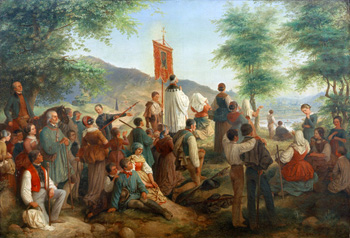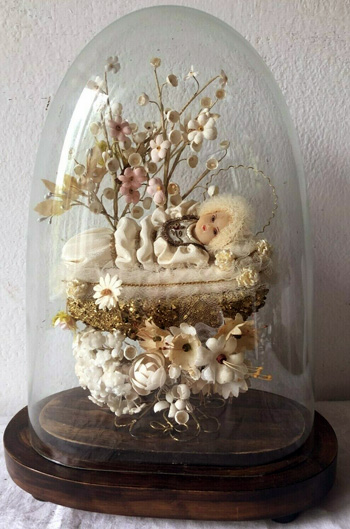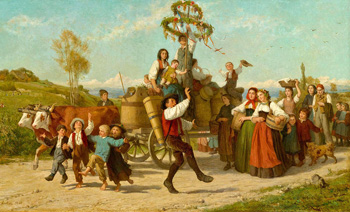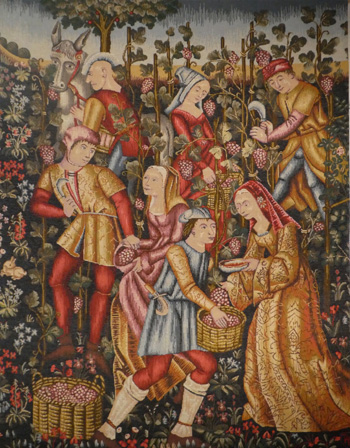Catholic Customs
 |
 |
 |
 |
 |
 |
 |
Commemorating the Nativity of Our Lady
The Feast of the Nativity of Mary, one of the major Marian feasts of the Church Year, originated in the Eastern Churches. There it was celebrated on September 8 or 9 since the earliest times. The Western Church gradually adopted the feast and by the 12th century it was made a Holy Day of Obligation. And so it remained until 1918.
A medieval legend explains how this feast day was introduced to the Western Church. In the 5th century, a pious French man from Angers had a vision on the night of September 8 in which he saw choirs of Angels singing jubilantly in Heaven.
 The man, filled with wonder, asked what this glorious sight meant since it occurred on this day and no other. He received the answer that the Angels rejoiced because the Blessed Virgin was born on that night, and Our Lord desired that the Church on earth should join the celestial choirs in celebrating this feast. The man went to the local Bishop, St. Maurilius, who established a feast in honor of the birth of Our Lady to be celebrated every year on September 8. (1)
The man, filled with wonder, asked what this glorious sight meant since it occurred on this day and no other. He received the answer that the Angels rejoiced because the Blessed Virgin was born on that night, and Our Lord desired that the Church on earth should join the celestial choirs in celebrating this feast. The man went to the local Bishop, St. Maurilius, who established a feast in honor of the birth of Our Lady to be celebrated every year on September 8. (1)
This Marian feast was especially dear to Catholic women of the past. In many central European countries this day was referred to as "Little Lady's Day" (Kleiner Frauentag) distinguishing it from the Great Lady's Day, the Feast of Assumption. (2)
Italian women who are named Maria celebrate this day as their name day. Many of them traditionally eat blueberries in honor of the blue of Our Lady's garments. (3) Bulgarian women refrain from work and bake bread that they distribute to neighbors and to the local monasteries. (4)
In some areas of Russia, on this day it was traditional for family members to visit newly-wed couples "to visit the young, to look at their life, to teach wisdom." A festive dinner followed with special toasts as the beer was brought to the table. By having this reunion on Our Lady's Nativity, the newly-weds were shown that Our Lady ought to be their model. (5)
Many Hungarians believed that the sun tossed roses from its beams on the Nativity of Our Lady. In the Hungarian villages along Central Ipoly, the women climbed the nearby hill to watch the sunrise on this day, hoping to see Our Lady surrounded with roses in the rising sun. (6) This belief is based on the Apocalypse where Our Lady is described as "A woman clothed with the sun" (Apoc 12:1).
Processions & Maria Bambina
The traditional time for pilgrimages to Marian shrines was the 30 days following the feast of the Assumption (August 15) until the feast of Our Lady of Sorrows (September 15). Statues or images of Our Lady in the cities and villages of Catholic Europe are often given special honor on one of the Marian feast days that take place during these 30 days.
 One of those feasts was the Nativity of Our Lady. Processions, fairs and pilgrimages took place at the Marian shrines to augment the joy of the day.
One of those feasts was the Nativity of Our Lady. Processions, fairs and pilgrimages took place at the Marian shrines to augment the joy of the day.
In many villages of Greece, it was a day of special ceremonies and grand processions, which often ended in a church dedicated to St. Anne; in this act of tenderness the people brought Our Lady to her Venerable Mother who bore her. To choose the man who would have the honor to carry the image of Our Lady in the procession, an auction was held and the privilege was given to the highest bidder. The money was then used to purchase a bull to be slaughtered for the feast that followed.
Often persons in these processions sought Our Lady's aid in their troubles and sorrows. Parents with sick children "sold" and handed over their children to Our Lady on the day of her Nativity, trusting that since they were now her slaves, she would heal them. The following year on the feast day, the parents bought their children – who were often healed and well – back from Our Lady. (7)
A similar auction was held in Orense, Spain. After Mass, the highest bidder was chosen to lead the cart carrying the image of Our Lady of La Franqueria to a platform in the central square. Two men, one dressed as a Moor and another as a Catholic, reenacted a lively and contentious scene where the Moor was eventually converted through the intercession of Our Lady. (8)

 Many Italian cities and villages have a special devotion to Our Lady's Nativity. In the hilly Langhe region in Piedmont, candles are placed in the windows of every house in the towns and the surrounding countryside. Bonfires are also lit on every hilltop in the area giving a glorious tribute to Holy Mary whose birth brought light to the world. (9)
Many Italian cities and villages have a special devotion to Our Lady's Nativity. In the hilly Langhe region in Piedmont, candles are placed in the windows of every house in the towns and the surrounding countryside. Bonfires are also lit on every hilltop in the area giving a glorious tribute to Holy Mary whose birth brought light to the world. (9)
Devotion to Maria Bambina (the Infant Mary) is a charming devotion that began in Italy and spread throughout Christendom. This devotion began as early as the 11th century when the church of Santa Maria Fulcorina in the Diocese of Milan was dedicated to the "mystery of the Nativity of Mary" in the year 1007. Five hundred years later, St. Charles Borromeo consecrated the Cathedral of Milan, dedicating it to the Nativity of Holy Mary (Santa Maria Nascenti).
These official acts of honoring Our Lady's Nativity led to the custom of making representations of Our Lady as an infant. This custom was especially popular during the Counter-Reformation.
In 1735, a Poor Clare Sister from Todi, Italy, whose name was Sr. Isabella Chiara Formari, made a wax depiction of the Maria Bambina. That image passed through the hands of many devotees until it was entrusted to the Sisters of Charity who brought the Bambina to their Motherhouse in Milan in 1876.
This Maria Bambina was exposed for veneration for the first time on September 8, 1884, and taken to the infirmary for the night to comfort the sick sisters there. A novice who was unable to move because of her serious illness begged the Infant Mary for the grace for her recovery. She was immediately and miraculously cured.
At the same time, the image itself miraculously changed colors from the faded dull gray facial hue to the vibrant colors of a infant's face. Soon many pilgrims began to flock to her chapel to ask for favors. (10)
The devotion gained in popularity and the custom spread of presenting a small wax Maria Bambina as a gift to newly-married couples. In France, the statue came to be placed on cushions under a glass globe, the Globe de Marie, which was also given to newly-married couples.
Changing Seasons & the Harvest
The Nativity of Our Lady falls in the month of the year that marks the end of the harvest and the beginning of the harvest festival season.
 For many Catholic peoples September 8 marked the end of summer. After that day the transition began from the summer practices to the autumn and pre-winter traditions.
For many Catholic peoples September 8 marked the end of summer. After that day the transition began from the summer practices to the autumn and pre-winter traditions.
In central and northern Europe peoples believed that the swallows began their journey south on this day. Austrian children recited this rhyme:
It's Blessed Virgin's Birthday,
The swallows do depart;
Far to the South they fly away,
And sadness fills my heart.
But after snow & ice & rain
They will in March return again. (11)
The reference to March refers to another Marian feast day, the Feast of the Annunciation on March 25, for it was a common belief that the swallows returned on that date. This association of the swallows with Marian feast days caused the Catholic Germans of old to see the swallow as a symbol of Our Lady. (12) This charming rhyme was brought to America by the Pennsylvania Dutch who recited it to their children. (13)
In the central European countries, September 8 began the season known as Nachsommer ("after-summer") when the winter crops were planted. In many churches, the winter seed grain was blessed on this day. (14)
This beautiful custom was so widespread that the blessing was included in the Roman Ritual. In Hungary, the man chosen to carry the seed to the church to be blessed was given the privilege to sow the first seed into the ground on the same day. (15)
 September is also the grape harvesting month. In some regions of France, the wine-growers celebrate this special feast by invoking Our Lady under the title of "Our Lady of the Grape Harvest." The new grapes are brought to the church where they are blessed by the priest. Several bunches of grapes are tied to the hands of a statue of Our Lady as a special offering to the Queen of the Harvest. After the ceremony, all partake in a festive meal featuring grapes. (16)
September is also the grape harvesting month. In some regions of France, the wine-growers celebrate this special feast by invoking Our Lady under the title of "Our Lady of the Grape Harvest." The new grapes are brought to the church where they are blessed by the priest. Several bunches of grapes are tied to the hands of a statue of Our Lady as a special offering to the Queen of the Harvest. After the ceremony, all partake in a festive meal featuring grapes. (16)
These Catholic peoples knew that the surest way to receive the blessings of their labor was by offering its fruit to Our Lord on a festival of His Blessed Mother. Our Lady's birthday most opportunely falls at the time of year when the harvest is ripe and the crops and livestock are at their best. What a wonderful tribute to She Who bore Christ Our Lord, Who would reap for mankind the greatest harvest of all.
Would that we who live in this cold industrialized modern world could return to these old ways of living. Then all – persons from every class and profession – would see the intimate connection between the natural world and the life of Our Lord and Our Lady as reflected in the Liturgical Year.

Posted September 6, 2021
A medieval legend explains how this feast day was introduced to the Western Church. In the 5th century, a pious French man from Angers had a vision on the night of September 8 in which he saw choirs of Angels singing jubilantly in Heaven.

The Nativity of the Virgin,
c. 1400 by Andrea de Bartolo
This Marian feast was especially dear to Catholic women of the past. In many central European countries this day was referred to as "Little Lady's Day" (Kleiner Frauentag) distinguishing it from the Great Lady's Day, the Feast of Assumption. (2)
Italian women who are named Maria celebrate this day as their name day. Many of them traditionally eat blueberries in honor of the blue of Our Lady's garments. (3) Bulgarian women refrain from work and bake bread that they distribute to neighbors and to the local monasteries. (4)
In some areas of Russia, on this day it was traditional for family members to visit newly-wed couples "to visit the young, to look at their life, to teach wisdom." A festive dinner followed with special toasts as the beer was brought to the table. By having this reunion on Our Lady's Nativity, the newly-weds were shown that Our Lady ought to be their model. (5)
Many Hungarians believed that the sun tossed roses from its beams on the Nativity of Our Lady. In the Hungarian villages along Central Ipoly, the women climbed the nearby hill to watch the sunrise on this day, hoping to see Our Lady surrounded with roses in the rising sun. (6) This belief is based on the Apocalypse where Our Lady is described as "A woman clothed with the sun" (Apoc 12:1).
Processions & Maria Bambina
The traditional time for pilgrimages to Marian shrines was the 30 days following the feast of the Assumption (August 15) until the feast of Our Lady of Sorrows (September 15). Statues or images of Our Lady in the cities and villages of Catholic Europe are often given special honor on one of the Marian feast days that take place during these 30 days.

A village pilgrimage
In many villages of Greece, it was a day of special ceremonies and grand processions, which often ended in a church dedicated to St. Anne; in this act of tenderness the people brought Our Lady to her Venerable Mother who bore her. To choose the man who would have the honor to carry the image of Our Lady in the procession, an auction was held and the privilege was given to the highest bidder. The money was then used to purchase a bull to be slaughtered for the feast that followed.
Often persons in these processions sought Our Lady's aid in their troubles and sorrows. Parents with sick children "sold" and handed over their children to Our Lady on the day of her Nativity, trusting that since they were now her slaves, she would heal them. The following year on the feast day, the parents bought their children – who were often healed and well – back from Our Lady. (7)
A similar auction was held in Orense, Spain. After Mass, the highest bidder was chosen to lead the cart carrying the image of Our Lady of La Franqueria to a platform in the central square. Two men, one dressed as a Moor and another as a Catholic, reenacted a lively and contentious scene where the Moor was eventually converted through the intercession of Our Lady. (8)

The miraculous Maria Bambina in the chapel in Milan; below, a Globe de Marie

Devotion to Maria Bambina (the Infant Mary) is a charming devotion that began in Italy and spread throughout Christendom. This devotion began as early as the 11th century when the church of Santa Maria Fulcorina in the Diocese of Milan was dedicated to the "mystery of the Nativity of Mary" in the year 1007. Five hundred years later, St. Charles Borromeo consecrated the Cathedral of Milan, dedicating it to the Nativity of Holy Mary (Santa Maria Nascenti).
These official acts of honoring Our Lady's Nativity led to the custom of making representations of Our Lady as an infant. This custom was especially popular during the Counter-Reformation.
In 1735, a Poor Clare Sister from Todi, Italy, whose name was Sr. Isabella Chiara Formari, made a wax depiction of the Maria Bambina. That image passed through the hands of many devotees until it was entrusted to the Sisters of Charity who brought the Bambina to their Motherhouse in Milan in 1876.
This Maria Bambina was exposed for veneration for the first time on September 8, 1884, and taken to the infirmary for the night to comfort the sick sisters there. A novice who was unable to move because of her serious illness begged the Infant Mary for the grace for her recovery. She was immediately and miraculously cured.
At the same time, the image itself miraculously changed colors from the faded dull gray facial hue to the vibrant colors of a infant's face. Soon many pilgrims began to flock to her chapel to ask for favors. (10)
The devotion gained in popularity and the custom spread of presenting a small wax Maria Bambina as a gift to newly-married couples. In France, the statue came to be placed on cushions under a glass globe, the Globe de Marie, which was also given to newly-married couples.
Changing Seasons & the Harvest
The Nativity of Our Lady falls in the month of the year that marks the end of the harvest and the beginning of the harvest festival season.

The swallows departing for the winter
In central and northern Europe peoples believed that the swallows began their journey south on this day. Austrian children recited this rhyme:
It's Blessed Virgin's Birthday,
The swallows do depart;
Far to the South they fly away,
And sadness fills my heart.
But after snow & ice & rain
They will in March return again. (11)
The reference to March refers to another Marian feast day, the Feast of the Annunciation on March 25, for it was a common belief that the swallows returned on that date. This association of the swallows with Marian feast days caused the Catholic Germans of old to see the swallow as a symbol of Our Lady. (12) This charming rhyme was brought to America by the Pennsylvania Dutch who recited it to their children. (13)
In the central European countries, September 8 began the season known as Nachsommer ("after-summer") when the winter crops were planted. In many churches, the winter seed grain was blessed on this day. (14)
This beautiful custom was so widespread that the blessing was included in the Roman Ritual. In Hungary, the man chosen to carry the seed to the church to be blessed was given the privilege to sow the first seed into the ground on the same day. (15)

A grape festival in an Italian village
These Catholic peoples knew that the surest way to receive the blessings of their labor was by offering its fruit to Our Lord on a festival of His Blessed Mother. Our Lady's birthday most opportunely falls at the time of year when the harvest is ripe and the crops and livestock are at their best. What a wonderful tribute to She Who bore Christ Our Lord, Who would reap for mankind the greatest harvest of all.
Would that we who live in this cold industrialized modern world could return to these old ways of living. Then all – persons from every class and profession – would see the intimate connection between the natural world and the life of Our Lord and Our Lady as reflected in the Liturgical Year.

A tapestry depicting a grape festival
- Francis X Weiser. The Holyday Book (London: Staples Press Limited), p. 111.
- https://www.brauchtum.de/de/herbst/mariae-geburt.html
- https://www.livinginseason.com/events/birthday-of-mary/
- Mercia MacDermott, Bulgarian Folk Customs (London and Philadelphia: Jessica Kingsley Publishers, 1998), p. 241.
- See here.
- See here.
- George A. Megas, Greek Calendar Customs (Athens: B. and M. Rhodis, 1963), p. 155.
- Nina Epton, Spanish Fiestas (Cranbury, New Jersey: A. S. Barnes and Company, 1969), pp. 184-185.
- Carol Field, Celebrating Italy (New York: William Morrow and Company, 1990), p. 135.
- https://udayton.edu/imri/mary/m/maria-bambina-devotion-to.php
- F Weiser, The Holyday Book, p. 113.
- https://www.brauchtum.de/de/herbst/mariae-geburt.html
- Don Yoder, Groundhog's Day (Stackpole Press).
- F Weiser, The Holyday Book, p. 112.
- See here.
- F Weiser, The Holyday Book, p. 112.
Posted September 6, 2021
______________________
______________________
 |
 |
 |
 |
 |
 |